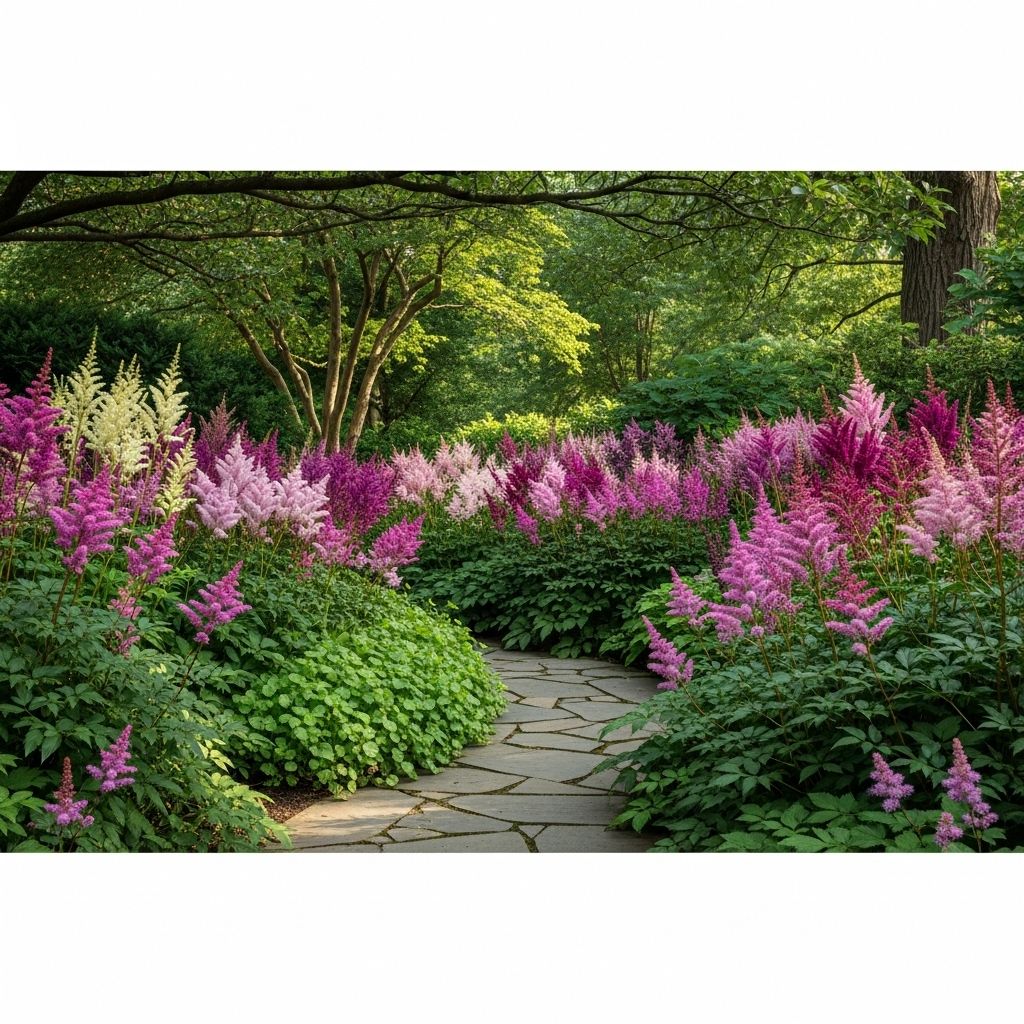19 Stunning Astilbe Varieties: Colorful Choices for Every Shade Garden
Feathery blooms and textured leaves bring long-lasting color to even the darkest beds.

Image: HearthJunction Design Team
If you want to add lush color and ethereal texture to your shade garden, few perennials rival astilbes for impact. With their feathery, plume-like inflorescences, deeply divided foliage, and dramatic shades ranging from flaming scarlet to the softest apricots, astilbe varieties create dynamic focal points and soften edges in mixed borders. In this detailed guide, you’ll discover 19 of the most beautiful and garden-worthy astilbes, as well as practical insights for using them to full effect.
Why Choose Astilbes for Your Garden?
- Shade Tolerance: Astilbes thrive in partial to full shade, making them ideal for woodland gardens and north-facing beds.
- Colorful, Lasting Blooms: Their flower plumes come in shades of red, pink, purple, apricot, and white, often lasting for weeks.
- Low Maintenance: Once established, astilbes require minimal care and return reliably each year.
- Attractive Foliage: Many varieties feature finely cut, fern-like leaves that add visual interest even after the flowers fade.
- Wide Hardiness: Most are hardy perennials, flourishing from USDA Zones 3 to 8.
Astilbe Varieties: Top Picks for Color and Texture
Below, you’ll find a rundown of 19 standout astilbe varieties. Each is described with information on their flower color, blooming time, typical height, and distinguishing features, helping you select the perfect match for your garden design.
1. Astilbe x arendsii ‘Fanal’
- Flower Color: Deep scarlet red
- Height: 24″ tall, 18″ wide
- Features: Narrow spires of red stand out atop classic lacey green foliage. The stems and leaves take on a subtle red hue as the summer progresses, creating added seasonal interest. Excellent mass planted for bold impact, with long-lasting blooms in early to midsummer.
2. Astilbe chinensis ‘Purple Candles’ (‘Purpurkerze’)
- Flower Color: Dark violet-red, softening to pale purple
- Height: Up to 5 feet
- Features: Dense, poker-like plumes create a dramatic look. Coarse, dark green foliage sometimes tinged bronze. Noteworthy for both its height and its unique flower form. Especially tolerant of sun and heat compared to many astilbes.
3. Astilbe ‘Delft Lace’
- Flower Color: Soft apricot-pink on deep red stems
- Height: 24–28″
- Features: Vigorous grower with glossy blue-green foliage that develops red highlights and a burgundy glow in autumn. Attractive even after flowering, thanks to persistent red seed heads. Blooms in early summer.
4. Astilbe ‘Peach Blossom’
- Flower Color: Soft peach to salmon-pink
- Height: 24–28″
- Features: One of the most popular pastel astilbes, prized for its fluffy plumes and elegant, compact habit. Blooms late spring to early summer.
5. Astilbe ‘Bressingham Beauty’
- Flower Color: Salmon-pink
- Height: 30–32″
- Features: Vigorous and upright, with large, luminous flower spikes held well above the foliage. Ideal for mass plantings or as an accent in shade borders.
6. Astilbe ‘Anita Pfeifer’
- Flower Color: Peach to pink tones
- Height: 18–24″
- Features: Compact and floriferous, producing many plume-like flowers in early summer. Lovely for small spaces and shade gardens with limited room.
7. Astilbe ‘Grete Pungel’
- Flower Color: Salmon-peach
- Height: 22–28″
- Features: Strong stems and fluffy flower heads brighten partial shade gardens. Pair with contrasting foliage for a dynamic effect.
8. Astilbe ‘Snowdrift’
- Flower Color: Pure white
- Height: 2 feet (61 cm)
- Features: Classic white form with feathery plumes in June and July. Elegant in shady borders, woodland edges, or next to darker-leaved plants.
9. Astilbe ‘White Glory’
- Flower Color: White
- Height: 3 feet (1 m)
- Features: Tall and statuesque white variety for bright spots in shaded or partially shaded gardens.
10. Astilbe ‘Bridal Veil’
- Flower Color: White
- Height: 30–36″
- Features: Notable for its striking bronze-tinged foliage, which enhances the billowy white blooms. Great for adding contrast and elegance to mixed shade plantings.
11. Astilbe ‘Granat’
- Flower Color: Deep red
- Height: 28–32″
- Features: An excellent, hardy red with robust stems and lasting blooms. Adds intensity to shady spots.
12. Astilbe ‘Glow’
- Flower Color: Vibrant deep red
- Height: 24–30″
- Features: Full plumes with strong coloration, especially striking when planted in groups.
13. Astilbe ‘Spartan’
- Flower Color: Deep red
- Height: 24–32″
- Features: Another excellent deep red with a vigorous habit, ideal for bold borders and shade gardens needing a pop of color.
14. Astilbe ‘Hyacinth’
- Flower Color: Purple-lavender
- Height: 24–28″
- Features: Unique for its rich lavender plumes, this variety brings a cool tone to mixed plantings.
15. Astilbe ‘Mars’
- Flower Color: Violet-pink
- Height: Up to 40″
- Features: Tall and commanding, with slender, upright plumes in a striking purple-pink shade. Looks impressive at the back of shady borders.
16. Astilbe ‘Purple Blaze’
- Flower Color: Deep purple
- Height: Nearly 5 feet (1.5 m)
- Features: One of the tallest astilbes, great for structure and drama. Its vibrant color and strong stems make it a show-stopper among shade perennials.
17. Astilbe chinensis ‘Visions’
- Flower Color: Raspberry pink
- Height: 18–24″
- Features: Noted for dense, fluffy flower heads and excellent drought tolerance compared to most astilbes. Adaptable and reliable in tough spots.
18. Astilbe ‘Finale’
- Flower Color: Soft pink
- Height: 9–12″
- Features: A truly dwarf variety, ideal for borders, containers, and the front of shade beds. Early blooming with delicate, pale pink plumes.
19. Astilbe simplicifolia ‘Sprite’
- Flower Color: Light pink
- Height: 9–12″
- Features: Compact, mounding habit with fine, divided foliage. Topped by delicate, airy plumes well suited for edging or rock gardens.
Choosing Astilbe for Your Garden: Tips and Combinations
When planning your shade garden with astilbes, consider the interplay of flower color, bloom time, and foliage. Mix varieties to extend the flowering season from late spring through mid-summer, and use both tall and compact types to create a layered look. Astilbes pair beautifully with hostas, ferns, brunnera, Japanese forest grass, and other shade classics.
Planting Tips
- Astilbes appreciate moist, well-drained, humus-rich soil.
- In cooler northern climates, many astilbes can tolerate more sun, but in warmer zones, keep them out of direct midday rays.
- Mulch to retain soil moisture and keep roots cool.
- Deadhead faded blooms for a tidier appearance, but leave the attractive seed heads for winter interest.
Comparison Table: Popular Astilbe Varieties
| Variety | Color | Height | Special Features |
|---|---|---|---|
| ‘Fanal’ | Scarlet red | 24″ | Long-blooming, strong stems, red-tinged foliage |
| ‘Purple Candles’ | Violet-red | Up to 5 feet | Heat/sun tolerant, dense poker-like plumes |
| ‘Delft Lace’ | Apricot-pink | 24–28″ | Glossy foliage, red seed heads, autumn interest |
| ‘Peach Blossom’ | Peach-pink | 24–28″ | Fluffy plumes, compact |
| ‘Snowdrift’ | White | 2 feet | Early white blooms, classic appearance |
| ‘Purple Blaze’ | Purple | Nearly 5 feet | Very tall, vibrant color |
| ‘Finale’ | Soft pink | 9–12″ | Dwarf, early-bloomer |
Frequently Asked Questions (FAQs)
Q: What is the best location for planting astilbe?
A: Astilbe thrives in partial to full shade with consistently moist, rich soil. They do best where they are protected from the hottest afternoon sun, especially in warmer climates.
Q: How do I keep astilbe plants healthy and vibrant?
A: Ensure soil stays evenly moist (mulching can help), avoid letting roots dry out, and feed in spring with a balanced fertilizer. Divide crowded clumps every 3–4 years for best flowering.
Q: Can astilbes be grown in containers?
A: Yes, dwarf varieties like ‘Finale’ and ‘Sprite’ are perfect for pots. Use a moisture-retentive potting mix and water regularly.
Q: When do astilbes typically bloom?
A: Bloom time varies by variety, ranging from late spring through mid-summer. Planting several types with different bloom periods helps prolong the display.
Q: Are astilbes deer resistant?
A: Astilbes are generally avoided by deer, making them excellent for gardens where browsing is a problem.
Conclusion
Astilbes bring effortless color, texture, and structure to shade gardens, thriving in spots where many other perennials fade. Whether you prefer bold scarlets, cool violets, soft pastels, or elegant whites, there’s a variety suited to every taste and setting. Mix them with other shade-loving plants to create dynamic, long-lasting displays—and enjoy their beauty for seasons to come!
References
- https://www.epicgardening.com/astilbe-varieties/
- https://www.americanmeadows.com/content/perennials/astilbe/all-about-astilbe
- https://www.longfield-gardens.com/article/all-about-astilbe/
- https://www.finegardening.com/article/12-brilliant-astilbes
- https://www.gardeningknowhow.com/ornamental/flowers/astilbe/types-of-astilbe.htm
Read full bio of medha deb












